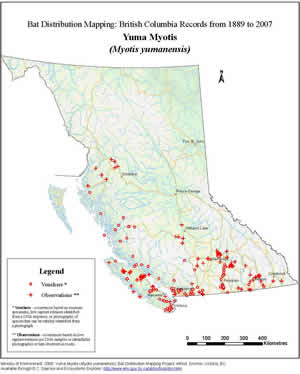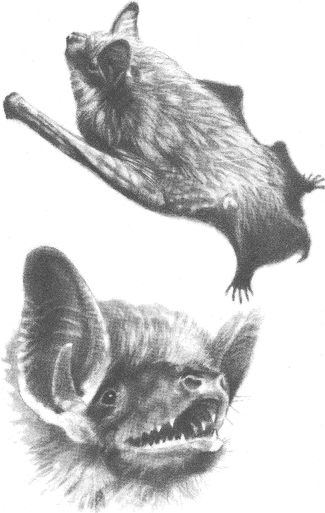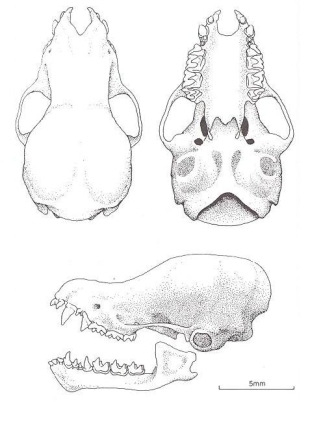Mating occurs in autumn and in British Columbia females bear a single young between early June and mid July. Birth dates for the Squilax colony range from 5 June to 21 July with most between 18 June and 7 July. Females generally breed in their first autumn, but the age when males reach sexual maturity is unknown.
|
Around dusk the Yuma Myotis emerges from its day retreat to hunt over lakes, rivers and streams. Individuals from the Squilax colony travel more than four kilometres to forage over rivers and lakes. In the Okanagan Valley, where this bat mainly feeds over water, aquatic insects such as mayflies, caddisflies and midges are the major prey. Midges are main food in spring; mayflies and caddisflies are the predominant food in summer. Although food habits have not been studied in other parts of the province, aquatic insects are probably the major prey throughout its range given this species tendency to hunt over water. An efficient hunter, the Yuma Myotis can fill its stomach in 10 to 15 minutes on a productive summer night. After feeding, it retreats to a temporary night roost near the feeding area.
|
Its summer day roosts are usually in buildings and other man-made structures in close proximity to water; it has also been found roosting in rock crevices in the Okanagan Valley. Maternity colonies in buildings can be enormous. One of the largest known colonies of bats in British Columbia comprises 1500 to 2000 adult female Yuma Myotis in an old church on the Little Shuswap Indian Reserve near Squilax. Females with young roost in the attic under shingles and boards. Temperatures in this attic may reach 40°C in the midday heat of summer. The degree of clustering in this colony corresponds with temperature: when the air is cool females tend to pack together in close contact, but in the afternoon heat they spread out throughout the attic. The Yuma Myotis also roosts in caves and trees, but colonies in these situations are usually small. Males roost separately from females, either alone or in small groups. (Adult males are virtually unknown in the large colony at Squilax.) Various man-made structures such as house porches, abandoned cabins and bridges serve as night roosts.
Maternity colonies are deserted by late summer or early autumn. In the Squilax colony, the population begins to decline in September and by late October the roost is abandoned. The whereabouts of the Yuma Myotis in winter is unknown. Despite the local abundance of this species, no winter hibernacula have been found in the province. The only known cold-weather record for the province is from Vancouver on 27 March. In coastal Washington a few individuals have been found hibernating in caves - it is possible that similar situations are used as hibernacula in British Columbia.
|
|


